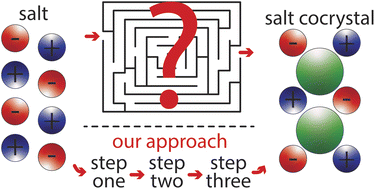Discovery strategy leads to the first melt-castable cocrystal based on an energetic oxidizing salt†
Abstract
Cocrystallization is a synthetic method employed across fields to improve functional materials while preserving properties inherent to the molecules/ions involved. However, there is no guarantee that cocrystals will demonstrate improved properties relative to the constituent materials. Oxygen balance, which is closely correlated to the performance of energetic materials, is an exception in that this attribute may be targetted with certainty. The combination of energetic oxidizing salts with small molecules presents a seemingly straightforward path to energetic materials with desirable performance properties. Unfortunately no general approach for the cocrystallization of salts and small molecules (salt cocrystallization) has yet emerged. Presented here is such an approach, focussing on ammonium salts, and applied to the energetic oxidizing salt ammonium dinitramide to achieve a melt-castable energetic material. Though focused on ammonium salts, this salt cocrystallization paradigm is a general approach that may be extended to other ions.



 Please wait while we load your content...
Please wait while we load your content...